There were 6 posts tagged: Call Center
Jabra Engage 50 digital corded headsets
 Five years ago, it was proclaimed that customers would no longer call into businesses; that they would prefer to find support via email, social and Chat channels, and organizations scrambled to train and ramp up those areas in their call centers (updating the terminology to "contact centers").
Five years ago, it was proclaimed that customers would no longer call into businesses; that they would prefer to find support via email, social and Chat channels, and organizations scrambled to train and ramp up those areas in their call centers (updating the terminology to "contact centers").Yet, here it is, almost 2020, and it turns out, customers are still calling businesses when they need help. Research has shown that customers start with online assistance for simple questions; however, as matters become more complicated, phone calls remain the preferred way to contact companies. This means that customer service agents are expected to know more detailed information and handle longer, complex calls. The pressure to produce results in a cost-efficient manner means that data analytics are crucial.
With this in mind, Jabra engineered a headset that meets these needs by offering digital sound, data analytics, Busylights on the ear speakers, and is comfortable to wear through long, demanding calls. The Engage 50 corded headset is available in both Mono and Duo versions and ends in USB-C. The generous-sized leatherette ear cushions have a conical design, so that the cushions rest securely on the ear.
How is the Engage 50 a Digital Headset?
A processing chip in the headset — rather than in a control unit or cord — makes the Engage 50 a digital headset. While most wireless headsets are already digital headsets, the Engage 50 is the first Jabra corded headset to have the chip in the headset itself. The Engage 50 uses the very latest chipset, and this, along with the positioning of the chip, delivers enhanced functionality and user experience. Along with Jabra Direct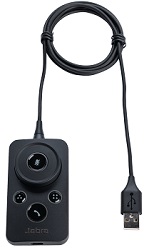 and Jabra Xpress, call analytics for the business, and on-screen microphone positioning guidance for the agents, are provided. A great headset, along with Jabra software, improves customer satisfaction.
and Jabra Xpress, call analytics for the business, and on-screen microphone positioning guidance for the agents, are provided. A great headset, along with Jabra software, improves customer satisfaction.
Engage 50 Link Control Unit
The control unit improves call control and the ergonomic design helps agents work more efficiently. It is an optional accessory; however, it must be purchased in order to use the Engage 50 with USB-A ports. There are four variations of the control unit:Jabra Engage 50 Link USB-A
Jabra Engage 50 Link USB-A Microsoft certified
Jabra Engage 50 Link USB-C
Jabra Engage 50 Link USB-C Microsoft certified
Data analytics and free Jabra software
Jabra Xpress 2.0 is designed for IT professionals to 100 percent remotely manage Jabra USB headsets and speakerphones with a set of smart tools. Xpress keeps different devices, across multiple locations and with numerous users, always updated with the latest firmware. Xpress offers easy mass deployment and agile maintenance.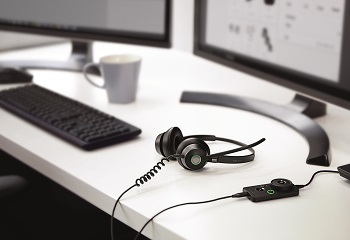 It works no matter the platform you work with, or whether you’re working from your own premises, your own cloud-based service, or the Jabra cloud. And, call analytics received from individual headset users help your management team make data-based decisions to improve agent productivity and the customer call experience. These comprehensive insights include background noise, speech analytics, headset usage analytics and audio exposure.
It works no matter the platform you work with, or whether you’re working from your own premises, your own cloud-based service, or the Jabra cloud. And, call analytics received from individual headset users help your management team make data-based decisions to improve agent productivity and the customer call experience. These comprehensive insights include background noise, speech analytics, headset usage analytics and audio exposure.Jabra Direct is a user-friendly desktop interface offering complete integration of your softphone and headset. The Jabra Direct dashboard is a user friendly status menu available from the desktop notification area, typically accessed via the lower right corner of the desktop.The dashboard shows the status of your headset, if any updates are available, and if your softphone(s) are ready for use. By clicking your Jabra device in the dashboard, you will be linked into the Jabra Direct main application for managing setting preferences, start firmware updates or access applications that are available for your headsets.
And did we mention, these software programs are available at no cost, for both Mac and Windows platforms?
To learn more about Jabra Engage 50 headsets, call our Headset Experts at 1-866-998-9991.
Why Scripts Don't Always Work
One of our employees received a personal message a few months back from an acquaintance who had started a new business: “Hey! Hope all is well! I am reaching out as I have recently joined [Company X]. Let me ask a few questions: are you currently using any face wash, do you have any dark marks, acne, fine lines/wrinkles, or sensitive skin? If you currently have a skincare regimen that you love, great! If you are looking for a new one or don’t have one (or even looking to even out your skin tones), let’s talk more. I would love to tell you more about [Company X] and would love your support in my new business endeavor.”
When our reply was “Congratulations on your new venture, we too love this brand and have been using it for a year” there was no reply. Not even a “Darn! Wish I was able to help you” or a “Way to go! You chose the right products!” We were a bit surprised by this and it then became very obvious that this new business person simply sent out a blanket message that was scripted from her company, with no thought beyond the initial message. Keep in mind, this person is a new Brand Ambassador for this company and a face of these products, and while surely disappointed in our reply, a quick response would have gone far in keeping a positive impression of this brand.
Wish I was able to help you” or a “Way to go! You chose the right products!” We were a bit surprised by this and it then became very obvious that this new business person simply sent out a blanket message that was scripted from her company, with no thought beyond the initial message. Keep in mind, this person is a new Brand Ambassador for this company and a face of these products, and while surely disappointed in our reply, a quick response would have gone far in keeping a positive impression of this brand.
This got us to thinking about scripts in general. A script enables quick communication and can be useful in some situations. Learning a new job can be overwhelming; providing sales scripts can be one of the ways to ease the burden of learning everything all at once. A framework and guidance in situations where nerves may get the best of you provide some peace of mind.
However, there are times when scripts are not useful, appropriate or well-planned. Interacting with others should be a natural process and not "forced." What happens when the other person doesn't answer the way the script says they should? Then what? Continuing to go down the path that the script lays out can be frustrating and counterproductive for both parties. Knowing when to go "off-script" is critical in building relationships. This values everyone's time throughout the process. Another key is to be sure to round out the conversation and always provide a genuine response.
When our potential customer doesn’t reply as we would hope they would (and let’s face it, this happens daily), let’s be sure we’ve formulated a plan of action for these types of responses and not leave the customer to think we don’t care. This is going to require a more natural, human response. I think we can all handle that, right?
When our reply was “Congratulations on your new venture, we too love this brand and have been using it for a year” there was no reply. Not even a “Darn!
 Wish I was able to help you” or a “Way to go! You chose the right products!” We were a bit surprised by this and it then became very obvious that this new business person simply sent out a blanket message that was scripted from her company, with no thought beyond the initial message. Keep in mind, this person is a new Brand Ambassador for this company and a face of these products, and while surely disappointed in our reply, a quick response would have gone far in keeping a positive impression of this brand.
Wish I was able to help you” or a “Way to go! You chose the right products!” We were a bit surprised by this and it then became very obvious that this new business person simply sent out a blanket message that was scripted from her company, with no thought beyond the initial message. Keep in mind, this person is a new Brand Ambassador for this company and a face of these products, and while surely disappointed in our reply, a quick response would have gone far in keeping a positive impression of this brand.This got us to thinking about scripts in general. A script enables quick communication and can be useful in some situations. Learning a new job can be overwhelming; providing sales scripts can be one of the ways to ease the burden of learning everything all at once. A framework and guidance in situations where nerves may get the best of you provide some peace of mind.
However, there are times when scripts are not useful, appropriate or well-planned. Interacting with others should be a natural process and not "forced." What happens when the other person doesn't answer the way the script says they should? Then what? Continuing to go down the path that the script lays out can be frustrating and counterproductive for both parties. Knowing when to go "off-script" is critical in building relationships. This values everyone's time throughout the process. Another key is to be sure to round out the conversation and always provide a genuine response.
When our potential customer doesn’t reply as we would hope they would (and let’s face it, this happens daily), let’s be sure we’ve formulated a plan of action for these types of responses and not leave the customer to think we don’t care. This is going to require a more natural, human response. I think we can all handle that, right?
Options for Side by Side Training with Headsets
Contact center staff members are at the front lines of engagement with your customers. Their success translates into happy customers, which is is why it's imperative to provide valuable, hands-on training from the start. If the new staff members will work on the phone, side by side training is especially a must; however, how the training is delivered depends upon several factors. Here's what you need before your new staff members arrive!
Training new staff, ongoing staff training, and supervisor drop-ins are all situations that are common in contact centers. Training cables (also known as supervisory cords, Y cords, or splitters) connect to Quick Disconnect (QD) headsets only. So if you are planning to roll out USB all-in-one headsets for your environment, make sure to order separate QD training set-ups. Currently, there is no side by side training set-up for all-in-one USB headsets.
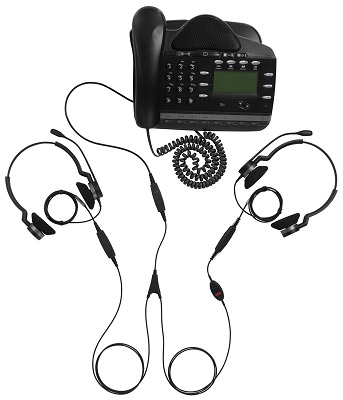
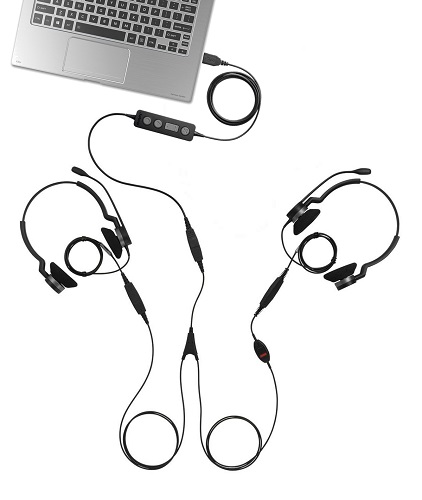
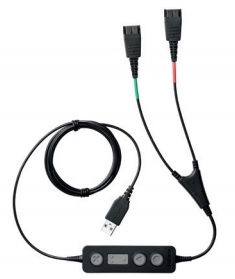
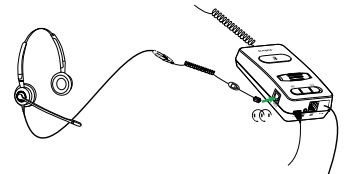
 The conferencing feature of wireless headsets allows connection of up to 4 (the primary headset + 3 additional) wireless headsets to a single base.
The conferencing feature of wireless headsets allows connection of up to 4 (the primary headset + 3 additional) wireless headsets to a single base.
With the primary headset in use, simply drop the second headset into the base. Once the secondary headset has been paired to the base, a tone will sound in the primary headset, and that headset must hit "Answer" to accept the secondary headset. To unpair, or disconnect the secondary headsets, simply dock them back into their own bases.
Read our complete blog post on how to accomplish training with wireless headsets, here: How to: Side by Side Training with Wireless Headsets.
We are always happy to walk you through this over the phone as well – give us a call anytime at 1.866.998.9991.
Training new staff, ongoing staff training, and supervisor drop-ins are all situations that are common in contact centers. Training cables (also known as supervisory cords, Y cords, or splitters) connect to Quick Disconnect (QD) headsets only. So if you are planning to roll out USB all-in-one headsets for your environment, make sure to order separate QD training set-ups. Currently, there is no side by side training set-up for all-in-one USB headsets.
Desk Phone Training
To begin, here's a traditional training set-up: a desk phone, 2 QD headsets connected to one direct connect lower cable by way of a Y cord. The Y cord shown has an inline mute switch, so that the second person can be either muted for listening to the conversation, or live, depending upon the situation. Depending upon the brand, Y cords can also have one side that's always muted.
Softphone Training
Training setups for the computer can be done a couple of ways. One is similar to the above mentioned desk phone setup. For example, in this image, there are two quick disconnect headsets, one Y-cord, and one QD to USB connection cable to the laptop (in this case, a Link 260). Another option is the Jabra Link 265.
Link 265
This Y-cord is the only one of its kind. The Link 265 from Jabra is a Y-cord that ends in USB. Connect two QD headsets to the Link 265 and connect via USB. It's that simple ... and cuts out one cord from the set-up above.
Amplifier Training
The Jabra Link 860 amplifier has a guest port for supervisors to connect into. Using the Link 850/860 QD Supervisory Cord with in-line mute, supervisors can immediately drop into a call and have the same functions as the primary headset.
Wireless Headsets
 The conferencing feature of wireless headsets allows connection of up to 4 (the primary headset + 3 additional) wireless headsets to a single base.
The conferencing feature of wireless headsets allows connection of up to 4 (the primary headset + 3 additional) wireless headsets to a single base. With the primary headset in use, simply drop the second headset into the base. Once the secondary headset has been paired to the base, a tone will sound in the primary headset, and that headset must hit "Answer" to accept the secondary headset. To unpair, or disconnect the secondary headsets, simply dock them back into their own bases.
Read our complete blog post on how to accomplish training with wireless headsets, here: How to: Side by Side Training with Wireless Headsets.
We are always happy to walk you through this over the phone as well – give us a call anytime at 1.866.998.9991.
Incentives in the Call Center Environment
Angela Garfinkel's recent blog post about the 3 types of employee motivation programs for call center agents provided guidelines for programs that work – in both the short- and long-term. How and when to offer these programs is critical in their overall success toward meeting goals and enhancing productivity in call centers. Another key factor is what to offer for incentives. We gathered a list of ideas for incentives that have had success in various organizations. We would also love to hear about programs that your organizations have implemented that were proven to be beneficial. Please share your successes in our Comments section.
These ideas are listed in order of least to more expensive:
Choice to work on projects they prefer. When an agent has met goals and earned the incentive, giving them a choice in the work that they do helps agent feel in control, and promotes buy-in and interest.
Certificates referring to goal met. Certificates can then be posted in the agent's work space, or a community area, such as break room.
Employee of the Month Parking Spot. This is a particularly valuable incentive if your organization has a large parking lot, and a parking space close to the building would be desirable.
Shift bids. This is an easy one: give agents the chance to bid on a preferred shift time before other employees can bid.
 Favorite candy or soda.
Favorite candy or soda.
Complimentary team lunch. This can be a catered lunch on site, or if possible, meet the team at a restaurant and spend an hour or two eating and getting to know each other.
Money. We found an anecdote on the Internet about a manager who spent his incentive budget on currency in denominations of $1, $5, $20, and $50 bills. Employees would reach in the bag to select their reward. People who selected the $50 got cheers, and the ones who got $5 knew that there were still $50 bills left in the bag!
Company gear. Items such as clothing, mugs, or office supplies can be nice incentives.
Goody bags of useful tools for desk or home. Tape, mini staplers, Post-It notes are a few ideas.
One extra 15-minute break time the day they meet goal. This can provide a nice change of pace for a day.
Small tokens/prizes. Koosh balls, small photo albums, crossword puzzle books or a decorative item for the agent's workspace can be a nice reminder of accomplishment while agents are on calls.
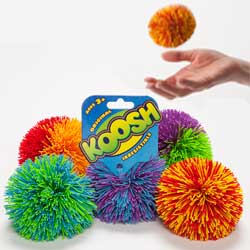 Afternoon snack from a fully-equipped snack cart. How fun to have a cart roll past your desk at an appointed time and you get to choose any snack from the cart!
Afternoon snack from a fully-equipped snack cart. How fun to have a cart roll past your desk at an appointed time and you get to choose any snack from the cart!
Gift certificates for massages, manicures, pedicures, movie passes. This idea works if your agents would value these types of gift certificates.
Gift cards to favorite stores or restaurants. Amounts can range from $5 (meeting a daily goal) up to $50.
Fun team activity. Bowling, miniature golfing, volunteering together on a Habitat for Humanity build, attending a hockey game or other sporting event, are just some activities that could build team morale.
Flexible hours, paid time off. This incentive involves your workforce management team, and would be more difficult to implement. For some agents, time is their most valuable resource; giving them some flexibility in their schedule, or an extra day off, could be a powerful motivator to reach goals.
This is not a comprehensive list of incentives, and we are always interested in hearing from you! Have you tried any of these incentives? Do you have a tried and true incentive that works well for your agents? Click on the orange Comments tab at the top of this post and please share your thoughts!
These ideas are listed in order of least to more expensive:
Choice to work on projects they prefer. When an agent has met goals and earned the incentive, giving them a choice in the work that they do helps agent feel in control, and promotes buy-in and interest.
Certificates referring to goal met. Certificates can then be posted in the agent's work space, or a community area, such as break room.
Employee of the Month Parking Spot. This is a particularly valuable incentive if your organization has a large parking lot, and a parking space close to the building would be desirable.
Shift bids. This is an easy one: give agents the chance to bid on a preferred shift time before other employees can bid.
 Favorite candy or soda.
Favorite candy or soda.Complimentary team lunch. This can be a catered lunch on site, or if possible, meet the team at a restaurant and spend an hour or two eating and getting to know each other.
Money. We found an anecdote on the Internet about a manager who spent his incentive budget on currency in denominations of $1, $5, $20, and $50 bills. Employees would reach in the bag to select their reward. People who selected the $50 got cheers, and the ones who got $5 knew that there were still $50 bills left in the bag!
Company gear. Items such as clothing, mugs, or office supplies can be nice incentives.
Goody bags of useful tools for desk or home. Tape, mini staplers, Post-It notes are a few ideas.
One extra 15-minute break time the day they meet goal. This can provide a nice change of pace for a day.
Small tokens/prizes. Koosh balls, small photo albums, crossword puzzle books or a decorative item for the agent's workspace can be a nice reminder of accomplishment while agents are on calls.
 Afternoon snack from a fully-equipped snack cart. How fun to have a cart roll past your desk at an appointed time and you get to choose any snack from the cart!
Afternoon snack from a fully-equipped snack cart. How fun to have a cart roll past your desk at an appointed time and you get to choose any snack from the cart!Gift certificates for massages, manicures, pedicures, movie passes. This idea works if your agents would value these types of gift certificates.
Gift cards to favorite stores or restaurants. Amounts can range from $5 (meeting a daily goal) up to $50.
Fun team activity. Bowling, miniature golfing, volunteering together on a Habitat for Humanity build, attending a hockey game or other sporting event, are just some activities that could build team morale.
Flexible hours, paid time off. This incentive involves your workforce management team, and would be more difficult to implement. For some agents, time is their most valuable resource; giving them some flexibility in their schedule, or an extra day off, could be a powerful motivator to reach goals.
This is not a comprehensive list of incentives, and we are always interested in hearing from you! Have you tried any of these incentives? Do you have a tried and true incentive that works well for your agents? Click on the orange Comments tab at the top of this post and please share your thoughts!
B2B Telemarketing Motivational Ideas That Work
Experts estimate the onboarding process of new call center agents can cost up to $10,000 per new hire. The recruiting process brings qualified call center agents to your organization; the training and mentoring processes integrate the agent into the organization's methods, procedures and beliefs; and strategic employee motivation programs can keep the agent feeling valued and appreciated. Call centers that overlook the human side of working will find the recruiting and training processes occurring more frequently than organizations that take the time to implement incentive programs. Great B2B Telemarketing employee motivation programs include 3 major components:
The author of this article, Angela Garfinkel, is the President and Founder of Quality Contact Solutions. Quality Contact Solutions offers B2B telemarketing solutions that achieve sales results.
-
1) Short-term: It is critical to provide specific, measurable and attainable goals to your B2B telemarketing call center agents on a daily basis. If the overall goal of the program is not attainable because a rep is newer or for reasons out of the call center rep's control, be sure to adjust your goals so that they are attainable by each person on the team. If you're afraid of the team shooting too low, set both a goal and a super goal. Super goal is usually about 25% higher than goal.
Be sure you are clear and specific about your expectations for accomplishment for that day and provide updates throughout the calling shift regarding actual performance and what level of performance is needed to finish at goal for the shift.
Periodically it works really well to provide a daily incentive to help boost performance over the top, particularly if you've had a couple of bad days in a row or have hit a plateau in performance. Be careful about overdoing daily incentives with your B2B telemarketing agents though because they will stop working if they are expected and not special.
2) Long-term: In a call center, I consider long-term to be a monthly incentive/recognition program. A month may not seem like a long time, but when you consider the real-time changes that the B2B telemarketing call center agents are dealing with, a month can be a considerable amount of time. I recommend that there be two levels of incentive/recognition on a monthly basis. One recommendation is setting a team goal and then rewarding the team for achieving their goal and also reward individuals for their individual contributions. Don't just give a top prize to the best seller each month though because it will end up demotivating the people who continuously end up as #2 or #3 and you need the entire team to feel like they are contributing and being rewarded appropriately.
3) Ad-hoc: What gets measured gets done. What gets rewarded and recognized gets done well. When you identify a specific area of opportunity with your B2B telemarketing agents (closing %, average order size, upsell %, etc.), a great way to get specific focus on improvement is through an ad-hoc incentive/recognition program focused on improvement in the focus area. I like the "Beat Your Best" contest where each B2B telemarketing rep is given an opportunity to earn recognition/incentives based on exceeding their best number(s) they have had within the past week, past month, etc. This gets people individually focused on improving and it will impact your team's performance overall.
The author of this article, Angela Garfinkel, is the President and Founder of Quality Contact Solutions. Quality Contact Solutions offers B2B telemarketing solutions that achieve sales results.

